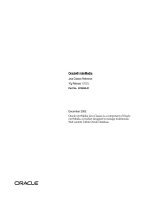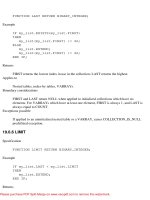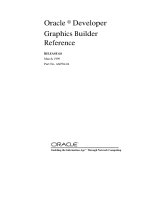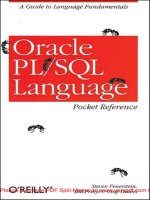Tài liệu Oracle PL/SQL Language Pocket Reference- P30 pptx
Bạn đang xem bản rút gọn của tài liệu. Xem và tải ngay bản đầy đủ của tài liệu tại đây (35.29 KB, 11 trang )
Oracle cannot automatically resolve such inconsistencies, but it does flag entries in the
DBA_2PC_PENDING view by setting the MIXED column to yes. When the database administrator
is sure that any inconsistencies for a transaction have been resolved, he or she can call the
PURGE_MIXED procedure.[4] The specification is:
[4] For more information on this topic, see "Manually Overriding In-Doubt
Transactions" in Oracle8 Server Distributed Systems .
PROCEDURE DBMS_TRANSACTION.PURGE_MIXED (xid VARCHAR2);
C.15.16 The
PURGE_LOST_DB procedure
The PURGE_LOST_DB procedure deletes information about a given in-doubt, distributed
transaction that has had mixed outcomes due to a lost database. This occurs when an in-doubt,
distributed transaction is able to commit or roll back on one node and other nodes have either
destroyed or recreated their databases. Oracle cannot automatically resolve such inconsistencies, as
described in PURGE_MIXED. The specification is:
PROCEDURE DBMS_TRANSACTION.PURGE_LOST_DB (xid VARCHAR2);
C.15.17 The
LOCAL_TRANSACTION_ID function
The LOCAL_TRANSACTION_ID function returns the unique identifier for the current transaction.
The function returns NULL if there is no current transaction. The specification is:
FUNCTION DBMS_TRANSACTION.LOCAL_TRANSACTION_ID
(create_transaction BOOLEAN := false)
RETURN VARCHAR2;
C.15.18 The
STEP_ID function
The STEP_ID function returns the unique positive integer that orders the DML operations of the
current transaction. The specification is:
FUNCTION DBMS_TRANSACTION.STEP_ID RETURN
VARCHAR2;
Previous: C.14 DBMS_SQL Oracle PL/SQL
Programming, 2nd Edition
Next: C.16
DBMS_UTILITY
C.14 DBMS_SQL
Book Index
C.16 DBMS_UTILITY
The Oracle Library
Navigation
Copyright (c) 2000 O'Reilly & Associates. All rights reserved.
Previous: C.15
DBMS_TRANSACTION
Appendix C
Built-In Packages
Next: C.17 UTL_FILE
C.16 DBMS_UTILITY
The DBMS_UTILITY package includes several utility modules you might find useful when
managing objects in the database.
C.16.1 The
ANALYZE_SCHEMA procedure
This procedure analyzes all the tables, clusters, and indexes in the specified schema. The
specification is:
PROCEDURE DBMS_UTILITY.ANALYZE_SCHEMA
(schema VARCHAR2,
method VARCHAR2,
estimate_rows NUMBER DEFAULT NULL,
estimate_percent NUMBER DEFAULT NULL);
C.16.2 The
COMMA_TO_TABLE procedure
The COMMA_TO_TABLE procedure parses a comma-delimited list and places each name into a PL/
SQL table. The specification is:
PROCEDURE DBMS_UTILITY.COMMA_TO_TABLE
(list IN VARCHAR2,
tablen OUT BINARY_INTEGER,
tab OUT uncl_array);
C.16.3 The
COMPILE_SCHEMA procedure
This procedure compiles all procedures, functions, and packages in the specified schema. The
specification is:
PROCEDURE DBMS_UTILITY.COMPILE_SCHEMA (schema VARCHAR2);
C.16.4 The
FORMAT_CALL_STACK function
This function formats and returns the current call stack. You can use this function to access the call
stack in your program. The specification is:
FUNCTION DBMS_UTILITY.FORMAT_CALL_STACK RETURN VARCHAR2;
C.16.5 The
FORMAT_ERROR_STACK function
This function formats and returns the current error stack. You might use this in an exception handler
to examine the sequence of errors raised. The specification is:
FUNCTION DBMS_UTILITY.FORMAT_ERROR_STACK RETURN VARCHAR2;
C.16.6 The
GET_TIME function
This function returns the number of 100ths of seconds which have elapsed from an arbitrary time.
Without GET_TIME, Oracle functions can only record and provide elapsed time in second intervals,
which is a very coarse granularity in today's world of computing. With GET_TIME, you can get a
much finer understanding of the processing times of lines in your program. The specification is:
FUNCTION DBMS_UTILITY.GET_TIME RETURN NUMBER;
C.16.7 The
IS_PARALLEL_SERVER function
This function helps determine if the database is running in Parallel Server mode. The specification is:
FUNCTION DBMS_UTILITY.IS_PARALLEL_SERVER RETURN BOOLEAN;
The function returns TRUE if the database is running in Parallel Server mode; otherwise it returns
FALSE.
C.16.8 The
NAME_RESOLVE procedure
This procedure resolves the name of an object into its component parts, performing synonym
translations as necessary. The specification is:
PROCEDURE DBMS_UTILITY.NAME_RESOLVE
(name IN VARCHAR2,
context IN NUMBER,
schema OUT VARCHAR2,
part1 OUT VARCHAR2,
part2 OUT VARCHAR2,
dblink OUT VARCHAR2,
part1_type OUT NUMBER,
object_number OUT NUMBER);
C.16.9 The
NAME_TOKENIZE procedure
The NAME_TOKENIZE procedure calls the PL/SQL parser to parse the given name that is in the
following format:
a [ . b [. c]] [@dblink ]
where dblink is the name of a database link. NAME_TOKENIZE follows these rules:
●
Strips off all double quotes
●
Converts to uppercase if there are no quotes
●
Ignores any inline comments
●
Does no semantic analysis
●
Leaves any missing values as NULL
The specification is:
PROCEDURE DBMS_UTILITY.NAME_TOKENIZE
(name IN VARCHAR2,
a OUT VARCHAR2,









